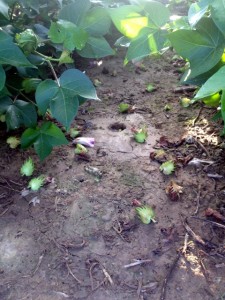I’ve had a request to do a running total of DD60 accumulations beginning August 15th. As much of our crop did not reach cutout (NAWF=5) by August 15th, this becomes our default last effective bloom date Continue reading
Recent Updates
A few reminders about insect control in cotton and soybean
Cotton: There are now a few mentions of bollworms being found in some cotton fields, although there have been no reports of high infestation levels. The suggested treatment threshold is 4 “surviving” larvae per 100 plants on Bt cotton fields. Typically, we do not Continue reading
PreHarvest Corn Yield Estimates
Early April planted corn is nearing black layer. Ear condition is decent for the most part, but we are seeing some sprouting on ears where hybrids have short, loose husks and some ears with diplodia or other molds. At this point, the best remedy to maintain ear quality is dry weather since ears are all turned upwards on plants. Yield potential is excellent in many areas around the state and should make for some interesting pre-harvest yield estimates. Continue reading
Cotton fruit-shedding – who’s to blame

Fruit shedding can be caused by bugs, disease, nutrient deficiencies, or the environment (as affected by weather or management). Even in the absence of pests and on fields with good fertility, it is common for a cotton plant to shed 60% of its squares and young bolls under typical growing conditions. Although fruit shed normally increases dramatically as the crop approaches cut-out, it can occur anytime and even with relatively small changes in the weather. What causes fruit shed and is there anything we can do to prevent it? Continue reading
Soybean Disease Update
With the rainy weather in Tennessee it’s not surprising disease is developing in soybeans. Specifically, southern blight and downy mildew have been reported. Continue reading
Crop Progress – Summarized from NASS
As reported by NASS on August 12, 2013
WET CONDITIONS PERSIST, HIGHER THAN AVERAGE YIELDS EXPECTED
Rain continued this past week, with only 3 days suitable for field work across the state. The down side of the persistent rainfall is the farmers’ inability to stay ahead of weed and insect problems. On a positive note, there are excellent chances of harvesting an exceptional crop this fall. Continue reading
Profitability Outlook
Prices and yields have been updated after the August 12th USDA Supply & Demand report. This August USDA report estimates yields based on producer surveys. For Tennessee, the estimated yields are above average with corn at 146 bushels/acre, cotton 979 lbs./acre, soybeans 42 bushels/acre and wheat at 68 bushels/acre. Continue reading
Tennessee Market Highlights
Tennessee Market Highlights for August 9, 2013 have been posted at http://economics.ag.utk.edu/market/tnmkt/2013/market080913.pdf. Continue reading

